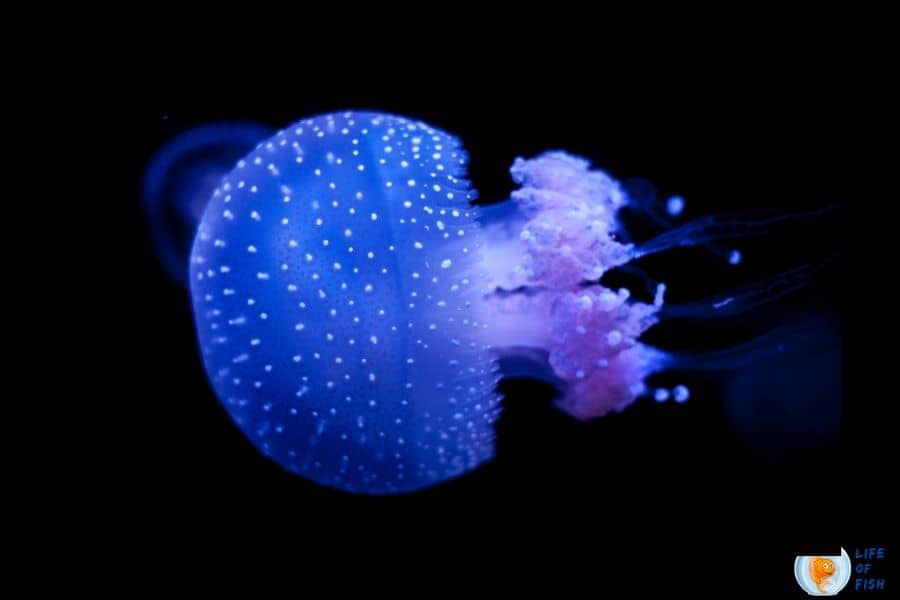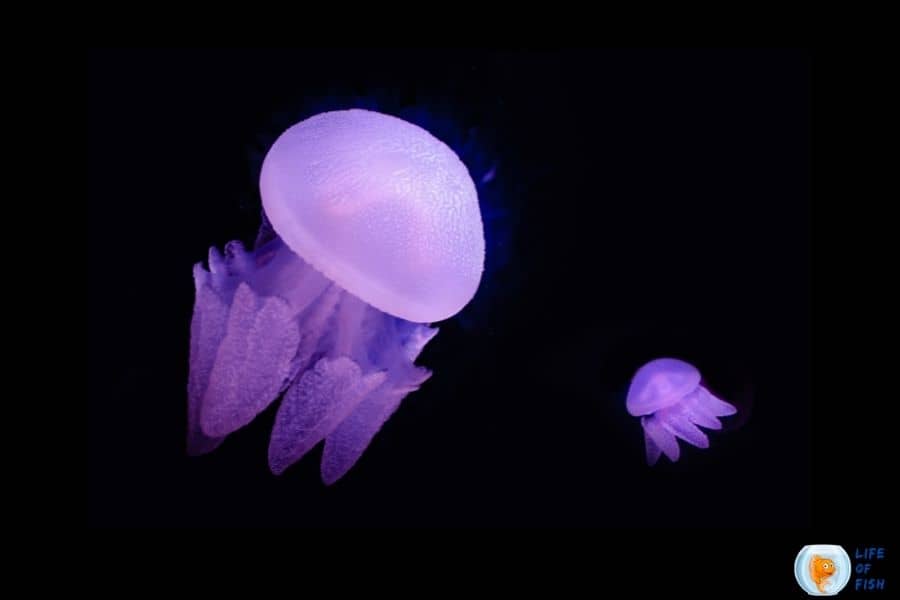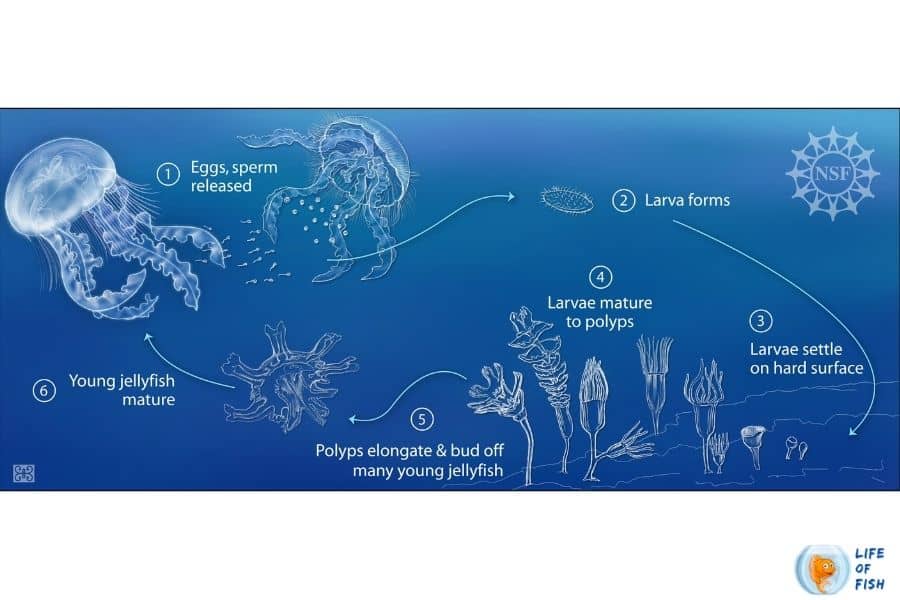Jellyfish are one of the most mysterious creatures in the animal kingdom. Scientists have so many questions related to them. one such question is; How long do jellyfish live? That time depends on jellyfish species. So, this article will reveal more secrets about this magnificent creation of nature that has been on the ocean since before the era of dinosaurs. Let’s dive in to find out some of their secrets.

How Long Do Jellyfish Live In A Tank or aquarium?
Jump To
- 1 How Long Do Jellyfish Live In A Tank or aquarium?
- 2 How Long Do Jellyfish Live In Captivity?
- 3 How Long Do Jellyfish Live Out Of Water?
- 4 How Long Do Jellyfish Live Up To?
- 5 How Long Do Jellyfish Live In The Wild?
- 6 What is immortal jellyfish?
- 7 How Long Do Box Jellyfish Live?
- 8 How Long Do Moon Jellyfish Live
- 9 More about jellyfish
- 10 Jellyfish Life Cycle
- 11 What Do Jellyfish Eat?
- 12 Do Jellyfish Sting Poisonous
The time period can be varied slightly within the species of jellyfish. Generally, moon jellyfish or common jellyfish can live for around 12 to 15 months. But your tank should meet the ideal conditions required to live jellies. On the other hand, other jellyfish species, such as blue blubber jellies, have a shorter lifespan. However, it is about 6 to 9 months. But rarely some jellyfish verities like sea nettles can live many years. But we conclude that, in general, jellyfish live for around one year in an appropriate marine tank.
How Long Do Jellyfish Live In Captivity?
Generally, jellyfish have a one-year lifespan. But this can vary within the jellyfish variety that you have. Moreover, the care for jellyfish is notoriously hard. So, you can shorten the life span of jellyfish and also make it slightly longer than average. As for how to do this, it depends on how you look after the jellyfish. If you provide ideal conditions and environment for your jellyfish, you can keep them in your captivity for around one year or more.
But If your care is poor, you have to give up the desire to keep jellyfish in your captivity for a long time. For instance, a slight change in the temperature can kill your jellies quickly. Additionally, you should be highly aware of the jellyfish variety that you are going to rear. Especially check whether the jellyfish species that can keep in captivity or not. Thus, there are many described and non-described jellyfish in the ocean.
How Long Do Jellyfish Live Out Of Water?
Jellyfish can not live out of water. Because like other marine creatures, jellies also need oxygen to live. However, jellyfish cannot live without water for a short time because they get oxygen from the seawater via the skin. In addition to that, when jellyfish are washing up on the beach, they will die. 95% of the body of jellyfish is water. Once they are on the beach, this water tends to evaporate. This process is called deliquescing. After a few hours under the sun, jellyfish are only imprinted on the sand.

How Long Do Jellyfish Live Up To?
Jellyfish live around 12 months on average, but this period can be varied with jellyfish variety. For instance, some tiny jellyfish live for a few days. Further, a common jellyfish variety is moon jellyfish, and they live around 12 to 15 months. But we can find cases that are entirely different from general rules. For example, some sea nettle jellyfish live for years.
How Long Do Jellyfish Live In The Wild?
Jellyfish live around one year or more in the wild. Comparatively, the lifespan of jellyfish in the wild is more extended than when they are in captivity. Usually, an animal’s ideal conditions are set up as the environment where they live in the wild. So, they live happily in the wild. Hence, this also applies to jellyfish.
What is immortal jellyfish?
According to marine biologists, there might be an immortal jellyfish. Yes, I said IMMORTAL. This immortal jellyfish (Turritopsis nutricula) has the ability to regenerate its cells into their original state and start the life cycle again from the beginning. But there is a critical discussion about this immortality and immortal jellyfish species in the scientific world.
How Long Do Immortal Jellyfish Live?
Apparently, immortal jellyfish live forever. Interestingly, long before dinosaurs became extinct, these creatures were reported floating in the ocean. It means 66 million years back period. And also, it has been biologically accepted that immortal jellyfish could have survived this entire time.
How Long Do Box Jellyfish Live?
In the ocean, box jellyfish do not live for more than 12 months. But in captivity, this highly depends on how you treat your jellyfish and the aquarium’s environment. Further, there are around 50 box jellyfish species in warm coastal water. So, the type of species also influences to increase or decrease in the lifespan of jellyfish slightly.
How Long Do Moon Jellyfish Live
Typically, adult jellyfish live around 12 to 15 months. On the other hand, the polyp has the ability to live up to 25 years.
More about jellyfish
If you are a beginner, the main question in your mind is, what is a jellyfish? So, let’s start with this. Simply jellyfish is a unique creature that lives in the ocean. This fantastic creature is known informally as jellyfish or Sea jellies but formally called medusa. So, I will use the common name, jellyfish, to recognize this planktonic marine member of phylum Cnidaria, the class Scyphozoa. Also, jellyfish belong to the group of invertebrate animals. However, if you research them, you can find around 200 described species.
This marine animal has bell or saucer-shaped trailing tentacles. Tentacles support them to catch prey. Further, there are two types of jellyfish. Any guess? The first one is free-swimming medusae, and another one is sessile, and this type of jellyfish lives attaching to the seaweeds and other objects on the sea bed by using a stalk. So, let’s see more about the lifespan of jellyfish.

Jellyfish Life Cycle
Mainly, jellyfish have a complex life cycle with six different stages. Below I discuss these six in detail.
Jellyfish eggs
In their life cycle, jellyfish reproduce sexually and asexually. in sexual reproduction, the female lays eggs. Then the male fertilizes them with his sperm. After that, fertilized eggs drift in the ocean currents freely. But exceptionally, some jellyfish give extra effort to protect their eggs. For instance, moon jellies tend to attach their fertilized eggs to the oral arms to protect their child. They do this until their babies are ready for their next phase.
Planula larva – jellyfish babies
In the second stage of their life cycle, small larvae are released into the ocean from eggs. At that time, you can call them planula. In this stage, tiny jellyfish have an oval structure and are likely similar to microscopic flatworms with tiny hairs, namely, cilia. Further, this little jellyfish can swim freely. Here their cilia support them to swim. Then a few days, this tiny planula larva floats on the surface of the ocean. You may be wondering whether or not this planula larva will become prey when it flows like this.
of course, yes, it can. If they are lucky to live, these planula larvae find a solid substrate to attach themselves after they are sufficiently large. Here, most of the time, they tend to attach pieces of the solid seabed. In some cases, these planula larvae attach themselves to the bodies of other large animals; most probably, it can be other adult jellyfish. So, after the planula larva finds a suitable substrate or surface to attach to, they will enter into the next phase.
Polyps – the long childhood of jellyfish
After attaching these little jellies, they develop into another stage, the polyp stage. Polyp can be defined as a small stalked animal. One end is attached to the substrate and another end extends into the water. Polyp’s mouth/anus is in the end that expands to the water, and it has a ring of tentacles surrounding the mouth. Another special thing is polyp has a completely developed digestive system. And they can catch prey and feed themselves.
The shape of the polyps is very similar to other marine animals like hydroids, corals, and anemones. If you know these marine animals, you can clearly identify that these animals have the same life cycle up to this stage. Another secret is jellyfish are able to remain at this polyp stage for years until the conditions are appropriate to mature.
Scyphistoma- budding teenagers
When it comes to the right time, conditions are ideal; polyps reproduce sexually by cloning themselves. Here polyps tend to elongate and then form segments. The final result can be developing an independent animal or even more polyps. Further, this process is called strobilation, while strobilation polyps are named scyphistoma.
Ephyra – the precursor of adult jellyfish
Ephyra is the name for jellyfish when little, budded segments of polyp convert into a free-living organism. Therefore, this stage can be distinguished as an anterior point of adult jellyfish. However, when we come to the size of ephyra, it is very tiny and no more than a few millimeters. But it is able to feed itself, so ephyra swims around, feeds and grows. Simply ephyra’s shape is not like an adult jellyfish. It means it does not have bell-shaped and stinging tentacles. Only it has undeveloped lobes of its bell, and it helps to push foods into its mouth.
Medusa – frisky adult jelly
When growing the ephyra, its bell gradually turns into a characteristic shape. On the other hand, tentacles and oral arms also grow progressively over time until they meet the unique shapes and sizes of the species. After finishing this process, we can say, yes, it is a medusa. In the early, medusa is small in size but fully formed adult jellyfish. Then over time, they will grow up.

What Do Jellyfish Eat?
Jellyfish do not tend to seek food actively. What they do is, capture the plankton float nearby. However, jellyfish feed many different types of foods. Basically, they eat different kinds of marine animals like shrimps, fish, crabs, and small fish called larvae and fish eggs. In addition to that, they feed on tiny plants (phytoplankton) and copepods (crustaceans). In sometimes, some jellyfish tend to eat other jellyfish. When jellyfish are forming blooms, they tend to eat almost everything in the ocean. If you rear marine fish with jellyfish, you have to face problems when foods are unavailable to eat jellyfish.
Do Jellyfish Sting Poisonous
Jellyfish use tentacles to sting and catch prey. They release the venom to paralyze their prey or targets. Jellyfish do not chase or go after humans, but humans have to face the stings of jellyfish under some circumstances. However, most of the stings are not emergencies, but it is painful. Also, you can expect pain, itching, red marks, tingling, or numbness. But in some cases, stings of some jellyfish types are very dangerous. Especially, the sting of box jellyfish can even kill you. These dangerous jellyfish mostly live in the Philippines, Australia, the Central Pacific Ocean, and the Indian Ocean.
Read Next: 13 Things You Most Likely Didn’t Know About Upside Down Catfish
